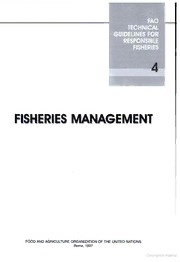
Fisheries management PDF
Preview Fisheries management
FAO TECHNICAL GUIDELINESFOR RESPONSIBLE Food FISHERIES and Agriculture Organization of the United Nations Copyrightedmateii MANAGEMENT FISHERIES FOODANDAGRICULTUREORGANIZATIONOFTHEUNITEDNATIONS Rome,1997 Copyrightedmaterial Reprinted1997,1999,2000 Thedesignationsemployedandthepresentationofthematerial inthisinformationproductiondonotimplytheexpressionofany opinionwhatsoeveronthepartoftheFoodandAgriculture OrganizationoftheUnitedNationsconcerningthelegalstatusof anycountry,territory,cityorareaorofitsauthorities,orconcern- ingthedelimitationofitsfrontiersorboundaries. ISBN92-5-103962-3 Allrightsreserved.Reproductionanddisseminationofmaterialinthis informationproductforeducationalorothernon-commercialpurposesare authorizedwithoutanypriorwrittenpermissionfromthecopyrightholders providedthesourceisfullyacknowledged Reproductionofmaterialinthis informationproductforresaleorothercommercialpurposesisprohibited withoutwrittenpermissionofthecopyrightholders.Applicationsforsuch permissionshouldbeaddressedtotheChief,PublishingandMultimedia Service,InformationDivision,FAO,VialedelleTermediCaracalla,00100 Rome,[email protected] ©FAO1997 Copyrightedmaterial -Ill PreparationofthisDocument ThepresentGuidelineshavebeencompletedbytheFisheryResourcesDivisionand the Fishery Policy and Planning Division, Fisheries Department, with the collaborationoftheFAOLegalOffice,onthebasisofinputsprovidedbymany expertsfromoutsideandinsideFAOoverthelasttwoyears,includingstaffof governmentlaboratories,universitiesandnon-governmentalorganizations.Wewish tothankinparticularthosewhoattendedtheExpertConsultationinNewZealand inJanuary 1995, ofwhomwe must mention MrR.Allen (Chairman, New Zealand),aswellasMrM.Lodge(U.K.)and MrM.P.Sissenwine(U.S.A.), Chairmenofthetwoworkinggroups. Several expertsalsodeserve individual mention:MrJ.F.Caddy(FAOFisheriesDepartment),whocoordinatedthework, MrB.Pollock(Australia)andMrJ.J.Maguire(Canada),whosubsequentlyhelped withredrafting. MrJ. Kurien(India)andMrT. Kenchington(Canada)also providedwritteninputs. AmongFAOstaff, D.Doulman,S.Garcia,R.Grainger, C.Newton,R.Welcotnme,U.WijkstromandR.Willmannassistedinvarious ways.ThefinaldraftwaspreparedbyA.BonzonandK.Cochrane. IthastobestressedthattheseGuidelineshavenoformallegalstatus. Theyare intendedtoprovidesupportfortheimplementationoftheCodeofConductfor ResponsibleFisheries. Furthermore,inordertopresentthemanagementprocess inallitscomplexityanddiversity,thewordingandstructureoftheseGuidelinesdo notfollowstrictlythelanguageandthestructureoftheCode. Therefore,any eventualdifferencesintheterminologyemployedshouldnotbeunderstoodas intendingreinterpretationoftheCode. Finally,itshouldberememberedthat,since theGuidelinesareintendedtobeflexibleandcapableofevolvingascircumstances change,orasnewinformationbecomesavailable,theymaybefurtherrevisedand complementedbyotherguidelines,notes,etc.,onspecificissues. Distribution: AllFAOMembersandAssociateMembers InterestedNationsandInternationalOrganizations FAOFisheriesDepartment FAOFisheriesOfficersinFAORegionalOffices InterestedNon-GovernmentalOrganizations Copyrightedmaterial -IV- FAOFish;ryResourcesDivisionandFisheryPolicyandPlanningDivision. Fisheriesmanagement. FAOTechnicalGuidelinesforResponsibleFisheries. No.4. Rome,FAO. 1997.82p. ABSTRACT TheseGuidelineshavebeenproducedtosupporttheimplementationofArticle 7oftheCodeofConductforResponsibleFisheries,withsomereferenceto Article12.Theyareaddressedprimarilytothedecision-makerswithinfisheries managementauthoritiesandotherinterestgroups,includingfishingcompanies, fishers’organizations,concernednongovernmentalorganizationsandothers. TheGuidelinesprovideabackgroundtotheneedforfisheriesmanagementand anintroductiontotheactivitiesencompassedbyfisheriesmanagement. They introducethemajorconstraintsexperiencedinfisheriesandfisheriesmanagement and some ofthe fundamental concepts related to these. Biological, environmental,technological,socio-culturalandeconomicconstraintsand conceptsareexamined. Informationisfundamentaltoresponsiblefisheriesmanagementandthese Guidelinesputemphasisontherangeofdatarequiredforinformeddecision- makingandexamineaspectsofthecollectionandinterpretationofthesedata. Dataarediscussedintermsofthreesuggestedscalesinfisheriesmanagement: fisheriespolicyanddevelopmentplanning,formulationofmanagementplansand implementationofmanagementaction. Therangeofpossiblemanagementactionsisoutlined.Thisincludestechnical measures,suchasgearrestrictions,andmoredirectapproachesintheformof directcatchlimitationoreffortlimitation. Theproblemsassociatedwithopen accessfisheriesareexplainedandcommentsmadeonthemeanstolimitaccess andobstacleswhichmaybeencounteredinthisprocess. Finally,theGuidelinesexaminethemanagementprocess. Thissectioncovers theprocessofagreeingonamanagementplanforafishery,includingtheneed forconsultationand,whereappropriate,cooperativedecision-making.Theneed forperiodicreviewofmanagementplansisstressed. Theimportanceofan effective legal framework, institutional and administrative structures and monitoringcontrolandsurveillancearedescribed. Copyrightedmaterial -V- Contents1 Page Background 1 Introductory NotetotheGuidelines forFisheriesManagement 4 1. INTRODUCTION 6 1.1 TheNeedforFisheriesManagement 6 1.2 TheFisheriesManagementProcess 7 1.3 BiologicalandEnvironmentalConceptsand Constraints 9 1.3.1 Resourceconstraints 9 1.3.2 Environmentalconstraints 11 1.3.3 Biodiversityandecologicalconsiderations 12 1.4 TechnologicalConsiderations 13 L5 SocialandEconomicDimensions 14 1.5.1 Socialandculturalconstraints 15 1.5.2 Economiccontextandconstraints 16 1.6 InstitutionalConceptsandFunctions 19 1.6.1 Institutionalcontextandcharacteristics 2Q 1.6.2 Roleandfunctionoffisheriesmanagement institutions 22 1.7 Time-scalesintheFisheriesManagementProcess 24 1.8 PrecautionaryApproach 25 2. MANAGEMENTDATAANDINFORMATION REQUIREMENTSANDUSE 26 2J GeneralConsiderationsintheCollectionandProvisionof DataandInformationforFisheriesManagement 27 2.1.1 Datarequirementsfordifferentmanagementscales 27 2.1.2 Verificationorvalidationofdata 27 2.1.3 Standardizationofdatacollection 28 1Throughoutthetext,referencestotheCodeofConductforResponsibleFisheriesareshowninitalics. ThesereferencesaremadeinbroadtermsanddonotslricUyfollowtheordernordotheycoverall occasionsonwhichissuesdealtwithbytheCodeofConductarereferredto. Referencestoother sectionswithintheseGuidelinesareshowninnormalfont. Copyrightedmaterial -VI- Page 2.1.4 Timelydistribution 29 2.1.5 Confidentialityofdata 29 2.1.6 Costsofcollectionandcollationofdata 30 2.2 DataRequirementsandUseintheFormulationof FisheriesPolicy 30 2.2.1 Typesoffisheries,thestockstheydependon andtheirecologicalandenvironmentalcontext 31 2.2.2 Fisheriescharacteristics 32 2.2.3 Socialandeconomicinformation 32 2.2.4 Monitoring,controlandsurveillance 34 2.3 DataRequirementsandUseintheFormulationof ManagementPlans 34 2.3.1 Thetargetstock,orstocks,anditsenvironment 35 2.3.2 Fisherycharacteristics 36 2.3.3 Socialandeconomicinformation 36 2.3.4 Monitoring,controlandsurveillance 39 2.4 DataRequirementsandUseintheDeterminationof ManagementActionsandMonitoringPerformance 40 2.4.1 Thetargetstock,orstocks,anditsenvironment 41 2.4.2 Fisherycharacteristics 42 2.4.3 Socialandeconomicinformation 43 2.4.4 Monitoring,controlandsurveillance 44 MANAGEMENTMEASURESANDAPPROACHES 45 3.1 OptionstoRegulateFishing 46 3.1.1 Technicalmeasures 46 3.1.2 Input(effort)control 48 3.1.3 Output(catch)control 50 3.1.4 Somegeneralconsiderations 51 3.2 LimitingAccess 52 3.2.1 Problemsassociatedwithopenaccess 52 3.2.2 Considerationsinlimitingaccess 52 3.3 ManagementinPartnership 55 THEMANAGEMENTPROCESS 58 4.1 FormulatingManagementPlanstoReflectSelected ObjectivesandConstraints 58 Copyrightedmaterial -vii- Page IdentifyingandAgreeingonObjectivesforthe Fishery 59 4.2.1 Theneedforconsultationwithrecognized interestgroups 59 4.2.2 Determiningtheappropriatemanagement measures 60 4.2.3 Reviewingthemanagementplan 61 4.3 Implementation 62 4.3.1 Effectivelegalandinstitutional framework 62 4.3.2 Effectiveadministrativestructure 65 4.3.3 Effectivemonitoringcontrolandsurveillance 67 DefinitionofSomeKeyTerms 70 Table1. Desirabledataandinformationrequirementsfor fisheriesatthelevelofpolicymaking,accordingto natureanduseofthedata 73 Table2. Desirabledataandinformationrequirements forfisheriesfortheformulationofmanagement plans,accordingtonatureanduseofthedata 76 Table3. Desirabledataandinformationrequirements forfisheriesforimplementationofthe managementplan,accordingtonatureand useofthedata 79 Table4. Outlineofpossibletopicsinafisherymanagement plan 81 This one 1 - - Background 1. Fromancienttimes,fishinghasbeenamajorsourceoffoodforhumanity andaproviderofemploymentandeconomicbenefitstothoseengagedinthis activity. However,withincreasedknowledgeandthedynamicdevelopmentof fisheries,itwasrealizedthatlivingaquaticresources,althoughrenewable,arenot infiniteandneedtobeproperlymanaged,iftheircontributiontothenutritional, economicandsocialwell-beingofthegrowingworld’spopulationwas tobe sustained. 2. Theadoptionin1982oftheUnitedNationsConventionontheLawofthe Seaprovidedanewframeworkforthebettermanagementofmarineresources. The newlegalregimeoftheoceansgavecoastalStatesrightsandresponsibilitiesforthe managementanduseoffisheryresourceswithintheirEEZs,whichembracesome 90percentoftheworld’smarinefisheries. 3. Inrecentyears,worldfisherieshavebecomeadynamicallydeveloping sectorofthefoodindustry,andmanyStateshavestriventotakeadvantageoftheir newopportunitiesbyinvestinginmodemfishingfleetsandprocessingfactoriesin responsetogrowinginternationaldemandforfishandfisheryproducts. Itbecame clear,however,thatmanyfisheriesresourcescouldnotsustainanoftenuncontrolled increaseofexploitation. 4. Clearsignsofover-exploitationofimportantfishstocks,modificationsof ecosystems,significanteconomiclosses,andinternationalconflictsonmanagement andfishtradethreatenedthelong-termsustainabilityoffisheriesandthecontribution offisheries to food supply. Therefore, the Nineteenth Sessionofthe FAO CommitteeonFisheries(COFI),heldinMarch 1991, recommended thatnew approachestofisheriesmanagementembracingconservationandenvironmental,as wellassocialandeconomic,considerationswereurgentlyneeded. FAOwasasked todeveloptheconceptofresponsiblefisheriesandelaborateaCodeofConductto fosteritsapplication. 5. Subsequently,theGovernmentofMexico,incollaborationwithFAO, organizedanInternationalConferenceonResponsibleFishinginCanctininMay 1992. TheDeclarationofCanctinendorsedatthatConferencewasbroughttothe attentionoftheUNCEDSummitinRiodeJaneiro,Brazil,inJune1992,which supportedthepreparationofaCodeofConductforResponsibleFisheries. The Copyrightedmaterial FAOTechnicalConsultationonHighSeasFishing,heldinSeptember1992,further recommendedtheelaborationofaCodetoaddresstheissuesregardinghighseas fisheries. 6. The OneHundredand Second Sessionofthe FAOCouncil, heldin November1992,discussedtheelaborationoftheCode,recommendingthatpriority begiventohighseasissuesandrequestedthatproposalsfortheCodebepresented tothe1993sessionoftheCommitteeonFisheries. 7. TheTwentiethSessionofCOFI,heldinMarch1993,examinedingeneral theproposedframeworkandcontentforsuchaCode,includingtheelaborationof guidelines,andendorsedatimeframeforthefurtherelaborationoftheCode. It alsorequestedFAOtoprepare, ona "fasttrack" basis, aspartoftheCode, proposalstopreventreflaggingoffishingvesselswhichaffectconservationand managementmeasuresonthehighseas. ThisresultedintheFAOConference,at itsTwenty-seventhSessioninNovember1993,adoptingtheAgreementtoPromote CompliancewithInternationalConservationandManagementMeasuresbyFishing VesselsontheHighSeas,which,accordingtoFAOConferenceResolution15/93, formsanintegralpartoftheCode. 8. TheCodewasformulatedsoastobeinterpretedandappliedinconformity withtherelevantrulesofinternationallaw, asreflectedintheUnitedNations ConventionontheLawoftheSea, 1982,aswellaswiththeAgreementforthe ImplementationoftheProvisionsoftheUnitedNationsConventionontheLawof theSeaof10December1982RelatingtotheConservationandManagementof StraddlingFishStocksandHighlyMigratoryFishStocks,1995,andinthelightof, interalia, the 1992DeclarationofCancun and the 1992RioDeclarationon EnvironmentandDevelopment,inparticularChapter17ofAgenda21. 9. ThedevelopmentoftheCodewascarriedoutbyFAOinconsultationand collaboration with relevant United Nations Agencies and other international organizations,includingnon-governmentalorganizations. 10. TheCodeofConductconsistsoffiveintroductoryarticles: Natureand Scope; Objectives; Relationship with Other International Instruments; Implementation,MonitoringandUpdatingandSpecialRequirementsofDeveloping Countries. These introductoryarticlesare followedbyanarticleonGeneral Principles, whichprecedes thesixthematicarticleson FisheriesManagement, FishingOperations,AquacultureDevelopment,IntegrationofFisheriesintoCoastal AreaManagement,Post-HarvestPracticesandTrade,andFisheriesResearch. As already mentioned, the Agreement to Promote Compliance with International Copyrightedmaterial
